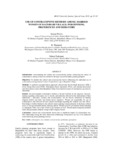| dc.contributor.author | Parvin, Kausar | |
| dc.contributor.author | Thaemert, K. | |
| dc.contributor.author | Turkmani, Sabera | |
| dc.date.accessioned | 2016-04-25T11:02:39Z | |
| dc.date.available | 2016-04-25T11:02:39Z | |
| dc.date.copyright | 2012 | |
| dc.date.issued | 2012-12 | |
| dc.identifier.citation | Parvin, K., Thaemert, K., & Turkmani, S. (2012). Use of contraceptive methods among married women of Bagnibari village: perceptions, preferences and behaviors. BRAC University Journal, Special Issue, 83–90. | en_US |
| dc.identifier.issn | 1811-3079 | |
| dc.identifier.uri | http://hdl.handle.net/10361/5185 | |
| dc.description | Includes bibliographical references (page 90). | |
| dc.description.abstract | Introduction: Understanding the cultural and socioeconomic factors influencing the choice of contraceptives among women are essential to having a successful family planning program.
Objectives: To identify the cultural and socioeconomic factors influencing the individual use of contraception among married women of reproductive age in Bagnibari village
Methods: A qualitative grounded theory approach collected data from In-Depth Interviews (IDI), a Focus Group Discussion (FGD), Participatory Rural Appraisals (PRA), and informal discussions and observations in peri-urban Bagnibari village from married women of reproductive age and key informants.
Results: The most popular contraceptive method is the pill followed by the injection. Decision-making regarding contraceptive use is directly and indirectly affected by the relationship of three dimensions – individual, cultural, and socioeconomic. All are heavily influenced by Muslim religious beliefs and male and female power dynamics. Women are responsible for use of contraceptives and often do not have proper knowledge regarding the methods and side effects. Knowledge is further limited by the cultural context placing women primarily in the home without access to non-governmental family planning options. Women perceive government family planning as inadequate. There was a lack of trust in government services. Women prefer temporary methods rather than permanent methods owing to their religious beliefs.
Conclusion: Cultural and socioeconomic factors have a significant impact on contraceptive use. The relationship among the three dimensions influencing contraceptive use has to be addressed when delivering family planning services. | en_US |
| dc.description.statementofresponsibility | Kausar Parvin | |
| dc.description.statementofresponsibility | K. Thaemert | |
| dc.description.statementofresponsibility | Sabera Turkmani | |
| dc.format.extent | 8 pages | |
| dc.language.iso | en | en_US |
| dc.publisher | BRAC University | en_US |
| dc.rights | BRAC University Journals are protected by copyright. They may be viewed from this source for any purpose, but reproduction or distribution in any format is prohibited without written permission. | |
| dc.subject | Contraceptive use | en_US |
| dc.subject | Cultural | en_US |
| dc.subject | Socioeconomic | en_US |
| dc.title | Use of contraceptive methods among married women of Bagnibari village: perceptions, preferences and behaviors | en_US |
| dc.type | Article | en_US |
| dc.contributor.department | James P Grant School of Public Health, BRAC University | |

